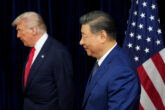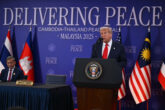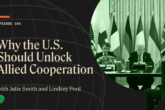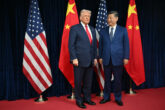October 10, 2025
CNAS Insights | Mr. President, You Are Losing India
Last month, after Xi Jinping, Vladimir Putin, and Narendra Modi clasped hands in Tianjin, China, President Donald Trump concluded that the United States had “lost India and Russia” to China. While Moscow and Beijing’s partnership—aimed at overturning the decades-old U.S.-led global order—predates the second Trump administration, India’s warming toward China is new. It is also a direct result of President Trump’s alienation of India in recent months.
The list is long. Trump has imposed one of the world’s highest tariff rates—50 percent—on India, including a 25 percent hike to punish New Delhi for buying Russian oil. Oddly, this means India now faces a far higher tariff for purchasing Russian energy than Moscow does for producing it. Trump’s senior trade counselor, Peter Navarro, has compounded tensions with insulting social media posts and by publicly wading into caste politics. The president has also repeatedly claimed credit for using tariffs to end the India-Pakistan conflict in May, despite New Delhi’s protestations to the contrary, and he hosted Pakistan’s army chief of staff in the Oval Office just weeks after a terrorist attack that India blames on a group harbored by Pakistan’s military.
It need not be this way. Indeed, it should not. India remains one of America’s most important strategic partners and a critical bulwark against a rising China.
It need not be this way. Indeed, it should not. India remains one of America’s most important strategic partners and a critical bulwark against a rising China. Consequently, multiple U.S. Democratic and Republican presidents over the last 25 years—including Trump himself in his first term—have invested in building economic and defense ties with India and establishing confidence and trust with the Indian people. Trump’s recent actions risk making him the president who lost India.
Whatever the facts, U.S. officials should not be surprised that India would deny any U.S. involvement in ending the four-day conflict with Pakistan. New Delhi has rejected third-party mediation in its dispute with Islamabad for more than 50 years, ever since the Simla Accords that ended the 1971 Indo-Pakistani War enshrined that all future disputes would be handled on a strictly bilateral basis. In addition, Modi faced fierce criticism from both his own political base and the opposition after Trump claimed that his trade threats produced a ceasefire agreement and repeated his offers to mediate the decades-old Kashmir dispute.
For all that, it is not too late to turn things around. To deescalate the current situation, both sides must be willing to compromise—a difficult task for two leaders who pride themselves on being seen as strong and unbending.
Yet a close examination of the facts suggests that each side has already taken some steps toward the other. India has shown signs of reducing its dependence on Russian oil which, before the invasion of Ukraine, constituted less than 1 percent of its oil imports. In July, India bought 24 percent less Russian oil compared to June, though some data and reports shows a marginal rise in August and September. Indian imports of US oil, in part because of competitive prices, substantially increased during this period. For Washington’s part, President Trump’s nomination of one of his closest political aides, Sergio Gor, as ambassador to New Delhi should be seen as an olive branch and an indication that he values the relationship.
It is not too late to turn things around. To deescalate the current situation, both sides must be willing to compromise – a difficult task for two leaders who pride themselves on being seen as strong and unbending.
It will, however, take more than these steps to right the bilateral ship. The two leaders should designate trusted advisors to quietly develop a roadmap for rescuing the relationship. That means cutting out the insults and social media posts that are damaging America’s reputation in India and souring the five-million-strong Indian American community on the Trump administration. It also requires moving quickly to finalize a trade agreement that will lower draconian tariffs on Indian goods in exchange for lower tariffs on American products and Indian commitments to purchase more U.S. energy and defense equipment. New Delhi should continue to reduce its purchases of Russian oil and President Trump should commit to visiting India and attending a Quad (United States, Australia, India, and Japan) summit as soon as possible.
The sight of India’s prime minister visiting China for the first time in seven years was unmistakably a signal to Washington that New Delhi has options. Let it be the last of its kind. The road to a genuine strategic partnership with India has been long and winding. Both countries should continue traveling down it.
Lisa Curtis is the director of the Indo-Pacific Security Program at the Center for a New American Security, as well as the former deputy assistant to the president and National Security Council senior director for South and Central Asia during the first Trump administration. Richard Fontaine is CEO of the Center for a New American Security and former foreign policy advisor to the late Senator John McCain.
More from CNAS
-
Indo-Pacific Security / Technology & National Security
Sharper: Tech + ChinaRecent talks between President Donald Trump and Chinese Communist Party General Secretary Xi Jinping placed a spotlight on emerging technologies, from high-end chips to minera...
By Charles Horn & Sevi Silvia
-
Thailand–Cambodia Border Agreement on Shaky Ground
Trump’s initial intervention was instrumental. Yet to secure both countries’ adherence to the accord, Washington must pair continued diplomatic pressure with tangible humanita...
By Ryan Claffey
-
Indo-Pacific Security / Transatlantic Security
Why the U.S. Should Unlock Allied CooperationAmerica’s allies are cooperating in a growing variety of domains. In their recent Foreign Affairs piece, former NATO Ambassador Julie Smith and former National Security Counci...
By Andrea Kendall-Taylor & Jim Townsend
-
Indo-Pacific Security / Technology & National Security
CNAS Insights | The Cost of Silence on China’s Cyber AggressionJust weeks before the much anticipated meeting between President Donald Trump and General Secretary Xi Jinping, the United States discovered yet another major China-backed cyb...
By Morgan Peirce




